A quick and easy, incredibly flavorful one-pot three cup chicken recipe (三杯鸡, Taiwanese San Bei Ji), loaded with garlic and ginger and braised in a sweet soy sauce which caramelizes into a very syrupy sauce that goes amazing with rice!
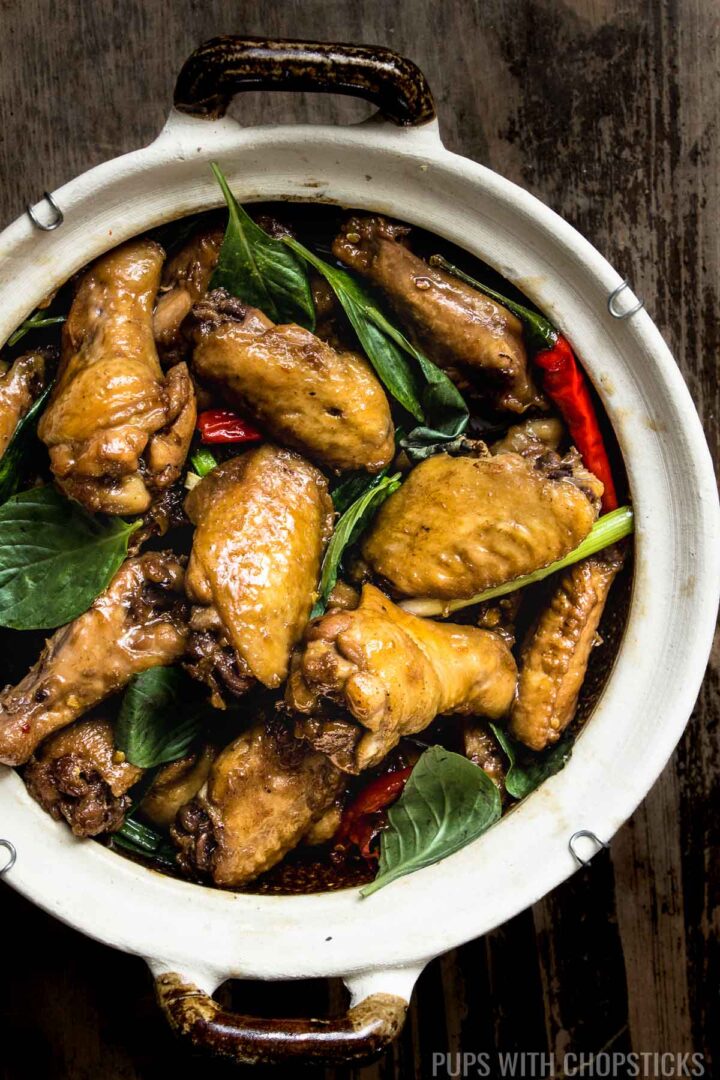
Table of Contents
What Is Three Cup Chicken?
Three cup chicken (三杯鸡, San Bei Ji) is a Taiwanese chicken dish that is traditionally made by braising chicken in a sauce made of 1 cup of soy sauce, 1 cup of cooking wine, and 1 cup of sesame oil, hence the name three cup chicken.
The chicken is braised with aromatics such as garlic, ginger, and chilies until the sauce has reduced into a concentrated syrupy sauce (which I think is the best part!).
For three cup chicken recipe, I use a lot less soy sauce, sesame oil, and Shaoxing wine, so that the sauce is not super salty and greasy. I also like to use onions/shallots and add fresh green onions (which is not traditional, but my own twist) to give this dish even more flavor! The magic is really in the flavorful sauce that goes absolutely amazing with white rice.
The best part of this san bei chicken recipe is, it uses only one pot and it's very quick and easy to make. From start to finish, the recipe takes about 30 minutes and since we are using chicken wings it cooks super quickly.
If you have a clay pot or a Chinese earthenware pot, you can also use that as well, just make sure you soak it in water before you use it to prevent the pot from cracking.
If you're looking for something cozy and similar to Taiwanese san bei ji recipe, I also have a Chinese beer braised pork belly recipe that you may enjoy as well!
Three Cup Chicken Ingredients and Substitutions
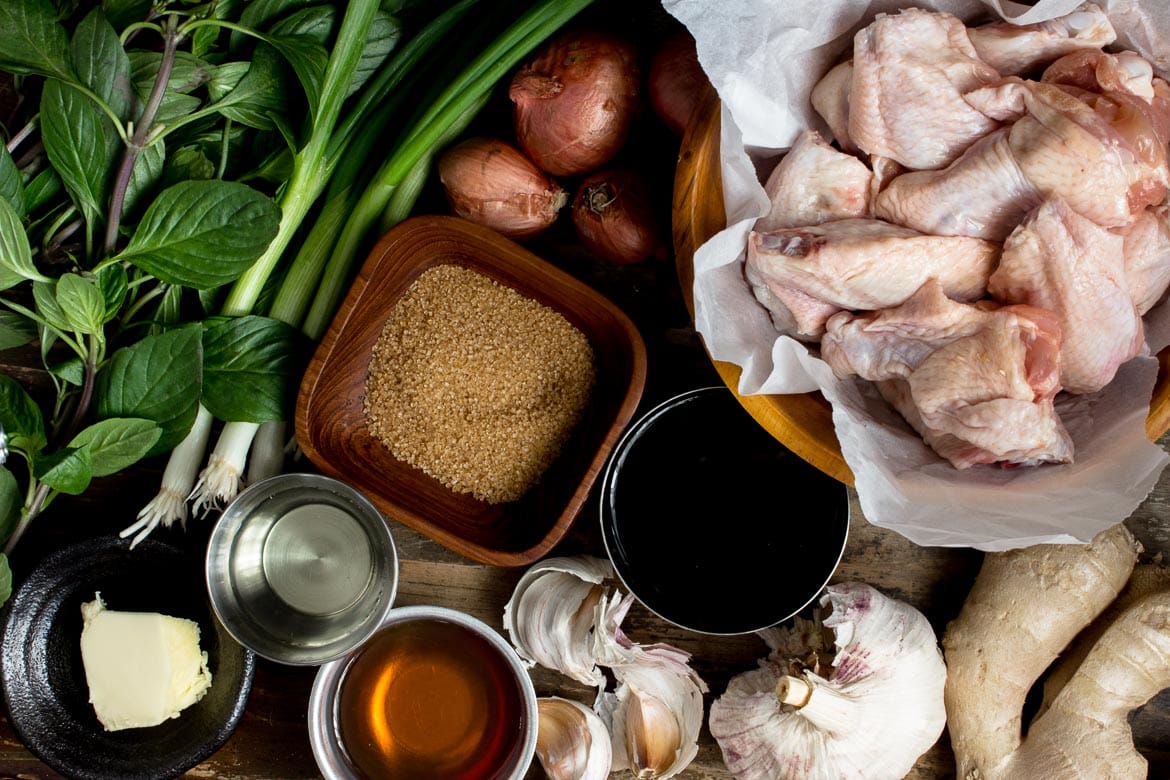
- Chicken Wings - Traditionally this is made with chunks of bone-in chicken pieces, but I prefer chicken wings and I find come out a lot tastier as well.
- Sesame Oil - Sesame oil is important in this recipe and gives a lot of flavor to this chicken dish. If you can't find it you can omit it but you will lose a bit of flavor without it.
- Garlic & Ginger - These ingredients are very important for this recipe and should not be omitted or substituted.
- Shallots - Personally, I think shallots are a lot more flavorful than onions, but in a pinch, you can substitute them with yellow onions as well.
- Birdseye Chili - This is an optional ingredient if you like spicy foods. 5-6 of these peppers will give this dish medium heat. You can use less to make it less spicy or more to make it spicier
- Shaoxing Cooking Wine - I use Shaoxing cooking wine for this recipe but if you can't find it you can substitute it with dry sherry or cooking sake.
- Soy Sauce - I like to use light soy sauce for this. If you can find a low-sodium one, it will work just as well.
- Dark Soy Sauce - This is used mainly to give the dish its dark color. If you cannot find it, you can omit it.
- Thai Basil - I like to make this dish with Thai basil for this but if you cannot find it, Italian basil will work as well, but the basil flavor will be a bit milder. Alternatively, you can also make this three cup chicken without Thai basil as well.
What Cuts of Chicken Can I Use?
Traditionally, three cup chicken (San Bei Ji) is made with chicken legs (drumstick and thighs) which have been chopped into smaller pieces using a meat cleaver (bone-in). Unfortunately, chopping the chicken this way may create bone fragments in this dish which is why I love using chicken wings instead.
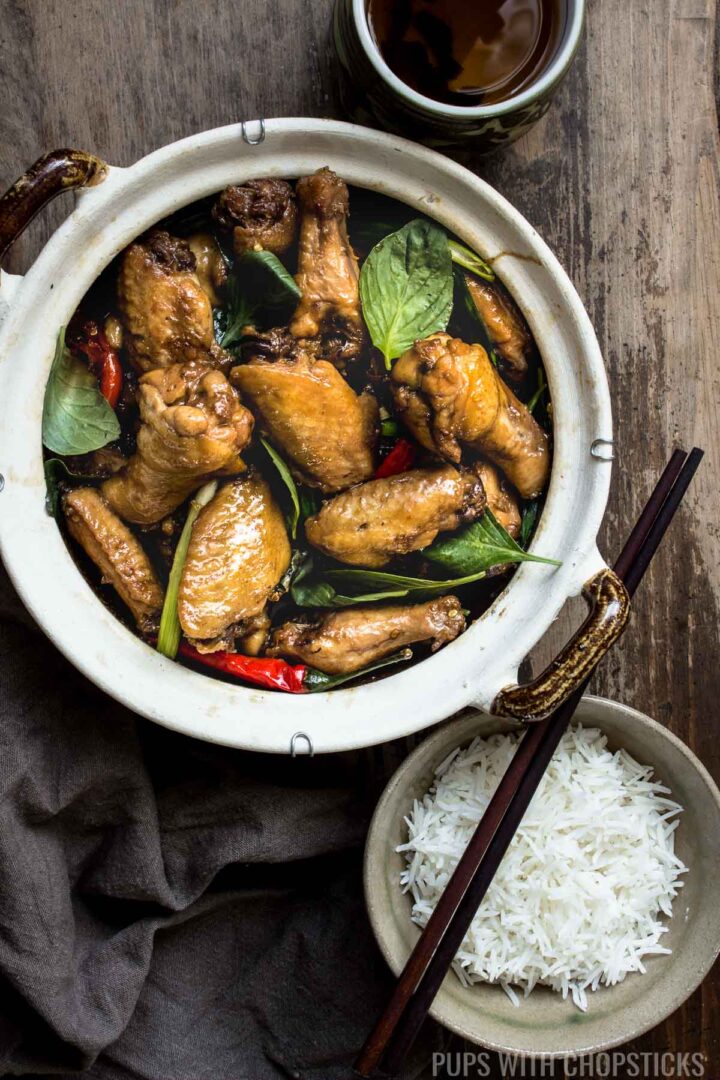
That being said, you definitely can use any type of chicken cut, here are a few ideas to get you started:
- Chicken wings (separated by segments) - I personally love eating wings. It's dark meat, and it's flavorful. To make it easier to eat the chicken wings should be separated by cutting them into separate pieces at the joint.
- Chicken thighs and drumsticks - Chicken drums are also another great alternative and are a lot meatier but it takes slightly longer to cook because of their size, with their bone-in and all. If you want to use chicken thighs, you will need to cut them into smaller pieces so that it is easier to braise, and so the sauce can absorb into the meat better.
- Boneless dark meat (any cut, cut into small chunks) - This is also an amazing alternative if you are okay with having no bone in your recipe. Every bite is bite-sized boneless meat so it's a lot easier to eat, and it also cooks a bit faster too.
- Boneless Chicken Breast (cut into small chunks) - If you're looking for a healthier cut of meat, white meat also works but you have to be careful not to overcook it so it stays tender and moist. I like to marinate the chicken chunks in a 1:1 ratio of soy sauce and water (like a mini brine) 1 hour ahead before using it. This mini brine draws the water into the meat (you'll notice the mini brine actually disappears and gets absorbed) which makes for a more moist chicken.
Tips
- Keep the Aromatics Big and Chunky - For this recipe, you want to keep the aromatics (ginger, garlic, shallots, chilies) big and chunky so they don't burn as easily since you will be toasting them in sesame oil for quite a bit of time (and so you can pick out the ginger slices easily before eating it). Don't worry, they won't stay big and chunky. The garlic and the shallots will eventually soften and melt into the sauce during the braising step.
- Add the Delicate Aromatics At the End - Delicate spices and aromatics like fresh Thai basil leaves will lose their flavor when it's cooked for too long. To keep this dish super flavorful, I like to add the green onions at the very end to soften it slightly and then turn off the heat before putting in the basil leaves. The residual heat from the chicken will wilt the basil slightly but will not cook out the flavorful basil oils.
- Whenever I make this dish, I find it quite salty. Especially, when the sauce starts to reduce at the end. I found that the best way to work around that is by adding water to the sauce. It will take a bit more time to reduce the sauce to thicken it but the sauce will be a lot less salty, without sacrificing any flavor.
- If you are using a claypot, make sure you soak it before you use it to prevent it from cracking.
How To Cook Three Cup Chicken
Prepare the Aromatics
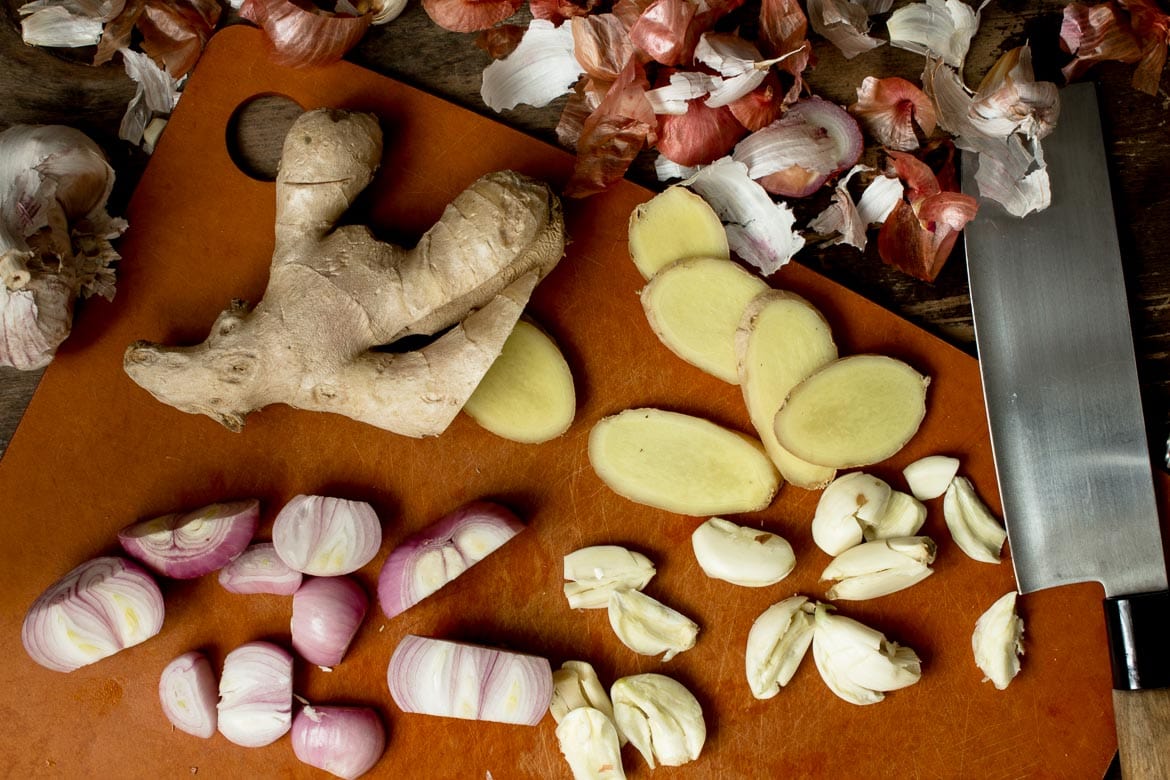
- Slice the ginger and set it aside for later
- Peel the garlic and use the side of a knife to smash it down to crush it. Do not cut them into small pieces, leave them intact so that they don't burn as easily. Don't worry it will soften and caramelize during the cooking process. Set it aside for later
- Peel and chop the shallots into 1 inch chunks. Set it aside for later
- Cut the green onions 2 inches lengthwise and set aside for the end
- Wash and pick the basil leaves off the stems and set them aside for the end
Make the Sauce
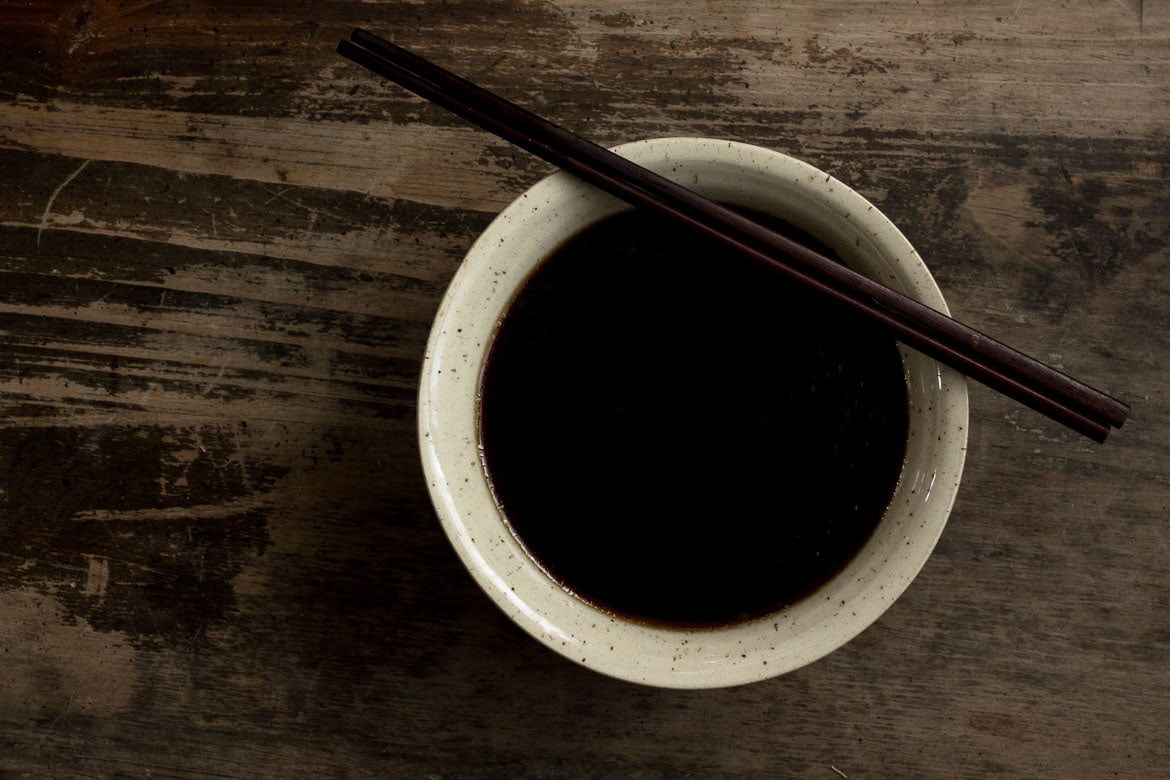
- In a bowl, combine the hot water and sugar. Stir it until the sugar has dissolved
- Once the sugar has dissolved, add the soy sauces and Shaoxing wine and mix well, and set it aside.
Cooking the Three Cup Chicken
- Set the stove to medium heat and add the sesame oil into a large pot. Try to use a pot with a tall wall to prevent the oil splatter from getting everywhere. If you are using a Chinese clay pot, make sure to soak it in water before you use it.
- When the oil is hot, add the ginger and toast it for about 3 minutes
- Once the ginger has toasted for a bit, add the shallots, chilies, and garlic and toast it for 2 minutes until it is golden brown.
- Add in the chicken and brown it for approximately 5 to 10 minutes. Keep the garlic on top of the chicken so it doesn't burn.
- Once the chicken has slightly browned, pour in the sauce and cover the pot with a lid. Adjust the heat to medium-low heat and let it braise for 10 minutes.
- Once 10 minutes is up, remove the lid and raise the heat back to medium heat. Let everything simmer for 8-10 more minutes (lid off). The sauce will start to caramelize and thicken.
- Once 8-10 minutes is up and the sauce should have thickened, if the sauce hasn't turned syrupy, continue to cook it without the lid for 1-3 minutes.
- Once the sauce is syrupy, add in the green onions and cook 1 minute.
- Turn off the heat and add in the basil and mix well.
- Enjoy with a bowl of rice! (don't eat the ginger slices! Remove them ahead of time, or when you're eating 🙂 )
More Classic Chinese Recipes You May Like
- Steamed Chinese Spare Ribs with Black Beans
- Chinese Tomato and Egg Stir Fry
- Beef & Onion Soy Sauce Noodles
- Easy Creamy Congee Recipe
- Sweet and Sour Pork
- Sweet and Sticky Char Siu (叉烧, Chinese BBQ Pork)
- Chinese Eggplant with Garlic Sauce (鱼香茄子)
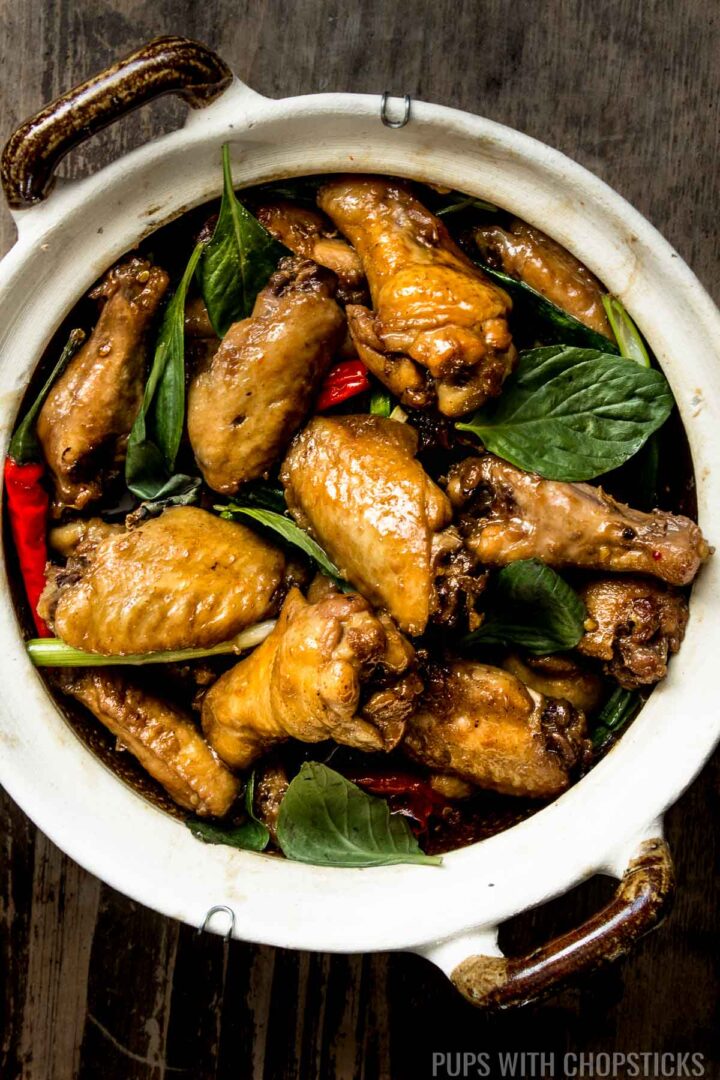
Did You Try This Three Cup Chicken Recipe?
If you made this 3 cup chicken recipe, I want to see! Follow Pups with Chopsticks on Instagram, snap a photo, and tag and hashtag it with @pupswithchopsticks and #pupswithchopsticks. I love to know what you are making!
If you like my recipes and want to be updated on when new ones come out, please consider subscribing to my newsletter (we don't spam) and follow along on Instagram, Facebook, and Pinterest for all of my latest recipes!
Recipe Card
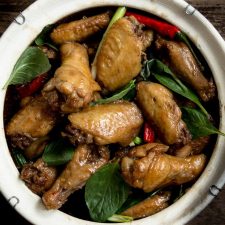
Three Cup Chicken (三杯鸡, Taiwanese San Bei Ji)
Joyce's Recipe Notes
- Keeping the onions into 1 inch chunks and smashing the garlic and keeping it intact, prevents it from being burned when you are browning them in the oil
- Delicate aromatics such as fresh basil loses a bit of flavor when it's cooked for too long. Using the residual heat from the dish to wilt it, maintains the flavors.
- If you cannot find Shaoxing wine, you can substitute it for dry sherry. If you substitute it with Dry Sherry, the sauce will be slightly sweeter.
- This recipe also works well with white meat. If you use white meat, cut it into bite sized chunks and marinate it in a mini brine of 2 tablespoons of soy sauce and 2 tablespoons of water for 1 hour before using the chicken. This will keep the chicken moist and tender, and won't overcook as easily.
- If you use boneless chicken, the sauce will need to use a corn starch slurry (1 tablespoon of corn starch mixed with 1 ½ tablespoon of cold water) to thicken the sauce at the end. The cartilage from the bones helps thicken the sauce to a thicker consistency.
Ingredients
- 2 lbs chicken wings (or any type of dark meat chicken)
- ¼ cup sesame oil
- 1 tablespoon butter (optional)
- 10 cloves garlic (smashed and intact, do not chop them.)
- 7 slices ginger (1x3 inches)
- 4 small shallots (or 1 small onion - cut into 1-inch chunks)
- 5-6 birdseye chili (medium heat. Use less to make it less spicy or more to make it spicier)
Sauce
- ½ cup Shaoxing Cooking Wine
- ¼ cup soy sauce (I like to use light soy sauce for this)
- 1 teaspoon dark soy sauce (optional)
- ½ cup hot water
- 3 tablespoons sugar
Delicate Aromatics (Add At The End)
- 3 stalks green onions (chopped into 2-inch length)
- 1 cup fresh basil leaves (I like to use Thai basil for this but in a pinch, Italian basil will work as well)
Instructions
Preparation
- Cut the 10 slices of ginger and set it aside for later
- Peel 10 cloves of garlic and use the side of a knife to smash it down to crush it. Do not cut them into small pieces, leave them intact so that they don't burn as easily. Don't worry it will soften and caramelize during the cooking process. Set it aside for later
- Peel and chop 4 shallots into 1 inch chunks. Set it aside for later
- Cut 3 stalks of green onions 2 inches lengthwise and set aside for the end
- Wash and pick 1 cup of basil leaves off the stems and set aside for the end
Making the Sauce
- In a bowl, combine the ½ cup of hot water and 3 tablespoons of sugar. Stir it until the sugar has dissolved
- Once the sugar has dissolved, add ¼ cup of light soy sauce, 1 teaspoon of dark soy sauce (optional) and ½ cup of Shaoxing wine.
- Mix it and set aside for later.
Putting It Together
- Set the stove to medium heat and add the ¼ cup of sesame oil into a small pot. Try to use a pot with tall wall to prevent the oil splatter from getting everywhere. Also try to use a pot that isn't too wide so that when you put the sauce in, it will be able to cover the chicken.If you are using a claypot, make sure you soak it before you use it to prevent it from cracking.
- When the oil is hot and shimmering, add the ginger and toast it for about 3 minutes
- Once the ginger has toasted for a bit, add the shallots, chilies and garlic and toast it for 2 minutes until it is golden brown.
- Add in the chicken and brown it for approximately 5 to 10 minutes. Keep the garlic, ginger, and shallots on top of the chicken so it doesn't burn.
- Once the chicken has slightly browned, pour in the sauce and cover the pot with a lid. Adjust the heat to medium-low heat and let it braise for 10 minutes.
- Once 10 minutes is up, remove the lid and raise the heat back to medium heat. Let everything simmer for 8-10 more minutes (lid off). The sauce will start to caramelize and thicken.
- Once 8-10 minutes is up and the sauce should have thickened, if it hasn't turned syrupy, continue to braise it without the lid for another 1-3 minutes.
- Once the sauce is syrupy, add in the green onions and mix well for 1 minute.
- Turn off the heat and add in the basil and mix well.
- Enjoy with a bowl of rice! (don't eat the ginger slices! Remove them ahead of time, or when you're eating 🙂 )
Nutrition
*Nutritional information is calculated using online tools and is an estimate*
Disclaimer: We are a participant in the Amazon Services LLC Associates Program, an affiliate advertising program designed to provide a means for us to earn fees by linking to Amazon.com and affiliated sites. While I appreciate the support – please try to buy your items locally if possible to support your local shops (chances are they are cheaper locally as well!)
More Easy Recipes to Try
- Chicken Khao Soi Recipe (Thai Coconut Curry Noodle Soup)
- Kimchi Fried Rice with Spam
- Honey Sriracha Chicken
- Teriyaki Chicken Yaki Udon (Stir-Fried Udon Noodles)
- Easy Chinese Beef and Broccoli Noodles
- Easy Japchae (Korean Glass Noodles Stir Fry)
- Spicy Pork Bulgogi (Classic Jeyuk Bokkeum Recipe)
- Easy Tteokbokki (Korean Spicy Rice Cakes)



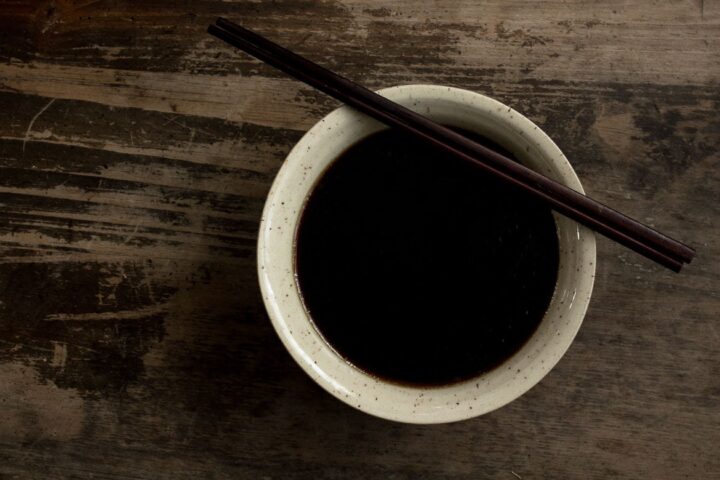
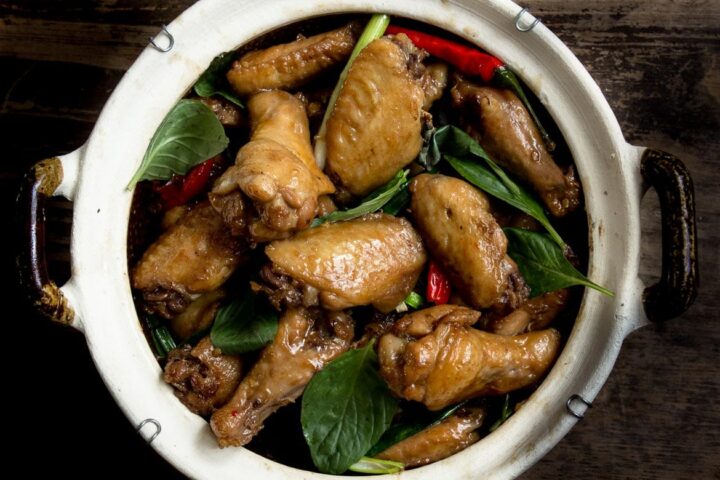
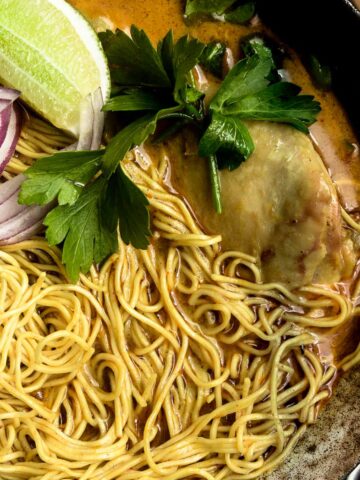
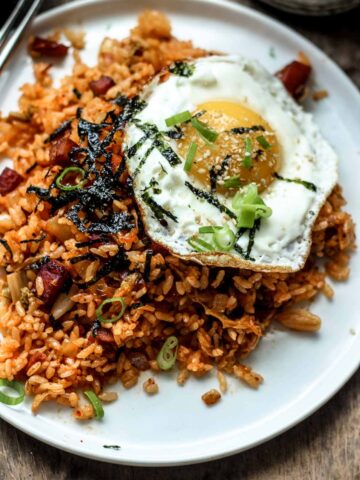
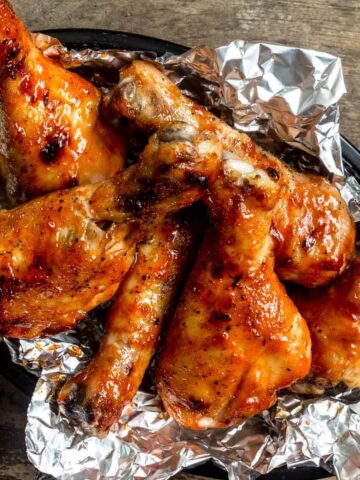
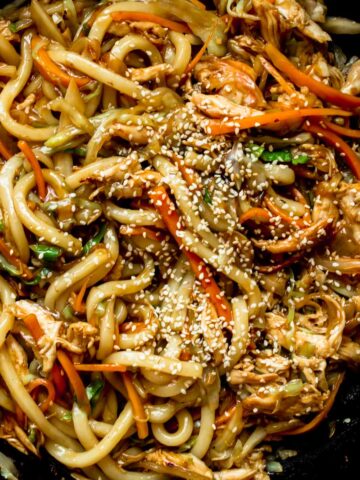
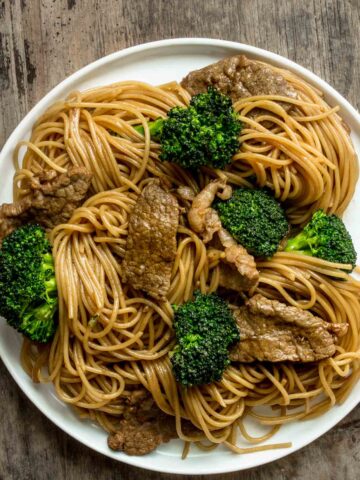
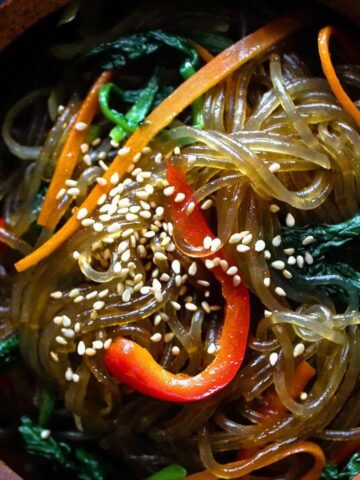
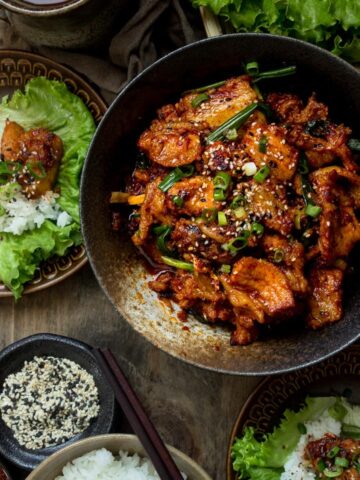
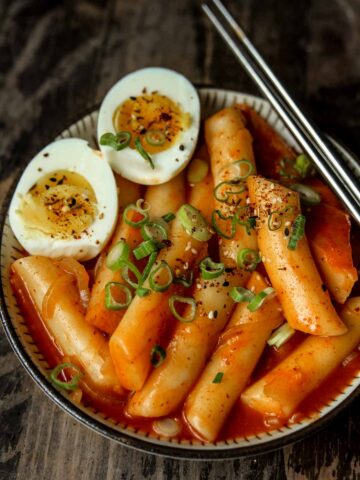
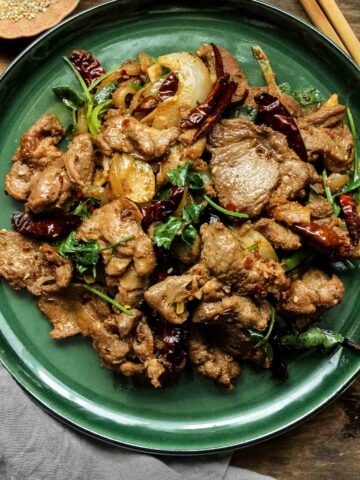
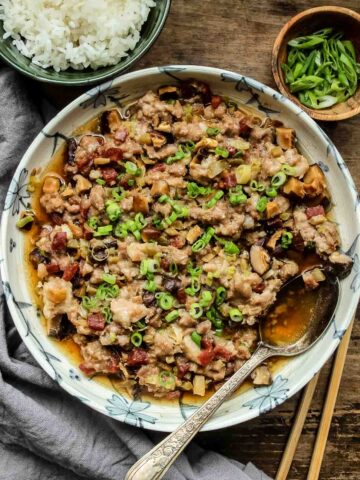
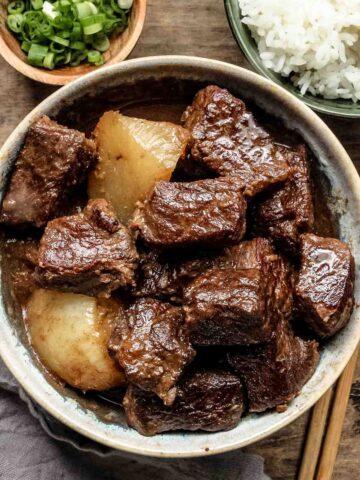
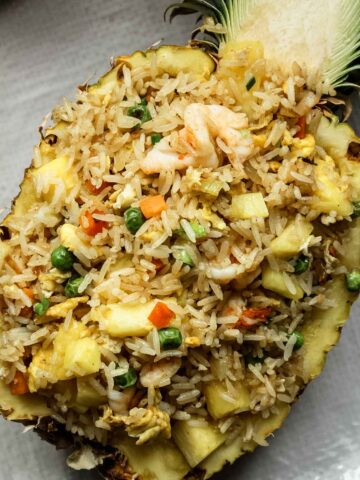
Jenn says
I finally made the double batch of these wings, following Joyce's tips for making in advance, and they turned out great! Five red Thai bird's eye chilies plus 4 green ones made a really nice medium spice level. Everything took longer for me though (getting the aromatics browned, and the wings didn't brown well given that there were so many) but it was worth it in the end! Great flavour. I ended up leaving the wings in the sauce to store and I felt that helped the flavour infuse even better. Will make them again for sure! Thanks Joyce!
Joyce says
YAAAAY!! I am so happy you made it and it turned out for you! 🙂 You're very welcome Jenn, I am very happy to help! You must have lots of leftovers! 😀 I love doing that too, heehee! Such a great way to have easy yum for days right? 🙂
Jenn says
Thanks for letting me know about doubling the ingredients, Joyce, as well as that you’d updated the recipe. Appreciate it.
I will make this tomorrow to eat later in the week... any tips on making/storing/reheating - am wondering if I should cook the chicken for less time? Or store the chicken and liquid separately, in case the sauce gets very gelatinous- wouldn’t want the wings to break up if I’m just scooping our a few wings at a time?
Joyce says
No worries, I'm always happy to help 🙂
Oh! I forgot to mention, since you're doubling the recipe you might have to cook the sauce a bit longer at the end to reduce it. (Under 'Putting It Together', step 6). Your chicken wings should be fine with the extra cooking time but in case you don't want them super soft, you can remove the wings from the pot when they have simmered in the sauce (lid off) for about 10 minutes and set them aside while the sauce reduces some more. Once the sauce has reduced to a semi-thicken state to your liking you can add the wings back into the thickened sauce with the green onions and basil. You don't need to do this extra steps (of removing the wings), I think the chicken wings will hold up fine with the extra 10 minutes of cooking time as long as you don't vigorously stir them, but it is an option. 🙂
Ah yes, the cold gelatinous sauce, the best part! haha 🙂 Yea if you have a lot of extra sauce, and you don't want to rip up the chicken and make it easier to separate for the next day then store the sauce in a separate container from the wings. They can be stored in the fridge with no issues otherwise. To reheat them, I like to use the microwave. If I pack it for lunch I put rice on the bottom of the container, put some wings on top of the rice, add some gelatinous sauce on top and once it's reheated in the microwave the rice is saucy! If I'm just eating them at home again, I just put the wings and sauce in the same bowl and reheat it in the microwave.
Hope this helps! and hope I make sense about the reducing of the sauce above! 🙂
Jenn says
Excellent. All great tips. Thank you Joyce!!
Joyce says
You're very welcome Jenn! Hope you liked it! 🙂
Jenn says
Could I use Thai basil instead of regular basil? Thanks!
Joyce says
Hi Jenn,
I usually use Thai basil for this dish 🙂 Sometimes when I don't have Thai basil around, I will substitute it with regular basil, but my preference is usually Thai basil.
Hope this helps! 🙂
Jenn says
Thanks Joyce! That's awesome because I bought a ton of extra Thai basil by accident 🙂 Look forward to trying this recipe!
Joyce says
Happy to help Jenn! 🙂 Hope you enjoy it!
Jenn says
Joyce, another question- if I plan to double the amount of chicken, should I also double the all the rest of the ingredients? Going to make it tonight or tomorrow 🙂
Joyce says
Hi Jenn,
Yup, if you're doubling the amount of chicken, then double the rest of the recipe so that there's enough sauce to cook it in. The worst-case scenario is you get extra sauce but the sauce tastes great on plain rice as well so the extra sauce is not a bad thing 🙂
Just a heads up as well, I updated the recipe a few days ago and reduced the sugar slightly, so make sure you're using the most recent one (not sure if you printed it out ahead of time, or if you were going to view it from your phone directly) 🙂
Inigo says
Do you use normal basil or holy basil , the Thai version slightly aniseed
Joyce says
Hi Inigo!
I have a hard time finding holy basil here where I live, so I always use the normal Thai basil (the one with the purple stems) for this dish. I am thinking of growing holy basil at home soon, thanks for reminding about this herb! 🙂
Louise says
Is rice wine different that Mirin?
Joyce says
Hi Louise,
Yup, they are a bit different. Chinese rice wine has salt in it, so it is slightly salty. Mirin has sugar in it, so I find it quite sweet. It wouldn't work very well in this recipe as a substitution since you need to reduce the sauce at the end and 1/4 cup of mirin reduced would make the sauce very sweet.
Hope this helps! 🙂
Makos says
Hey Joyce!
I can already imagine myself liking my fingers after eating this chicken 🙂
(also, for some reason I can't rate the recipes)
Joyce says
The sauce is definitely my favorite part, and I do have to lick my fingers while eating this haha! 😀
Hmmm I will have to look into the rating part, thank you for the heads up! 🙂
John says
Could you direct me to a 'traditional ' version of this so that I may learn the effects of your variations?
Rice wine: shaohsing ok?
Light, medium, or dark soy sauce?
I enjoy your blog
Joyce says
Hi John,
This is the traditional recipe, I just adjusted the soy sauce, rice wine and sesame oil amounts so that it's not super salty and greasy.
The only thing I tweaked about is by adding shallots and green onions for extra flavor. You can omit those if you like.
Yes, you can substitute shaoxing wine for the rice wine with no issues at all 🙂
I use regular soy sauce for this recipe, I switch between Pearl River Light Soy and Lee Kum Kee's Soy Sauce (the red labeled one, which I think is medium soy sauce). Dark soy sauce is too syrupy and thick and will not work very well with the recipe and will make the final dish almost black in color.
Hope this helps! 🙂 and thank you for your kind words about the blog. I'm always happy to share yums, and also learn from my readers as well 🙂